First applied research with high-energy ion beams of the NICA Complex
News, 01 March 2023
At the Joint Institute for Nuclear Research, as part of the fourth commissioning run at the NICA Accelerator Complex, researchers started for the first time applied research using accelerated ion beams with energies of the order of several GeV per nucleon. Specialists of five research centres participating in the ARIADNA (Applied Research Infrastructure for Advance Development at NICA fAcility) collaboration have performed a series of irradiation of samples at a specially equipped stand at the BM@N experimental zone. The stand allows long-term irradiation of samples in parallel with the operation of the BM@N facility and is suitable for a wide range of tasks.
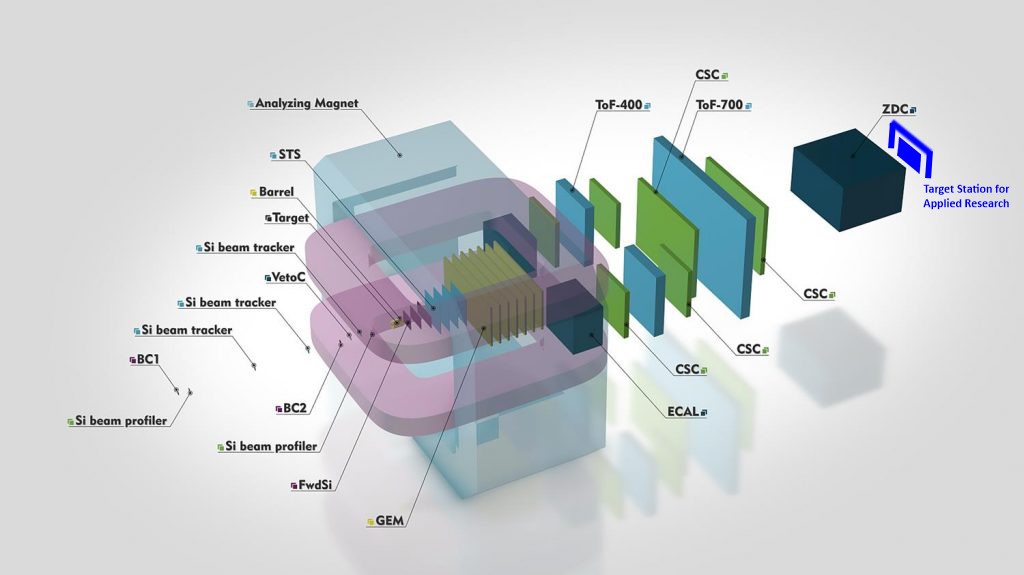 Location of the sample irradiation stand at the BM@N experimental zone (Target Station for Applied Research – on the right)
Location of the sample irradiation stand at the BM@N experimental zone (Target Station for Applied Research – on the right)
 Location of the sample irradiation stand at the BM@N experimental zone
Location of the sample irradiation stand at the BM@N experimental zone
Deputy Head of the VBLHEP JINR Department of Methodological Research and Innovation Oleg Belov said that the 124Xe54+ beam obtained during the commissioning cycle was well focused and quite stable. It allowed implementing the planned scientific programme in terms of applied tasks.
“The completed run opened a new page in the history of applied research at extracted Nuclotron beams and marked the start of the ARIADNA scientific programme on time. Just over a year ago, the SOChI station (Station Of Chip Irradiation) was put into operation at the NICA Complex to irradiate microchips with relatively low-energy ions – 3.2 MeV/nucleon. Today, we have a beam with energies several orders of magnitude higher – 3.8 GeV/nucleon, which significantly extends the possibilities for carrying out applied research,” Oleg Belov said. He noted that specialists were carrying out the irradiation of samples at the BM@N experimental zone from 11 December 2022 to 30 January 2023, and the run turned out to be very intense.
Employees of several Russian research centres participated in joint work at the beams of the NICA Complex: the RAS Institute of Biomedical Problems (IMBP RAS), the RAS N. N. Semenov Research Centre of Chemical Physics, the A. F. Tsyba Medical Radiological Research Centre, a branch of the Federal State Budgetary Institution National Medical Research Centre for Radiology of the Russian Ministry of Health (MRNC named after A. F. Tsyba, Obninsk), the Mendeleev University of Chemical Technology of Russia (RCTU), The RAS Joint Institute for High Temperatures (JIHT RAS). A number of organizations indirectly participated as developers of various innovative materials or innovative approaches to the experiment.
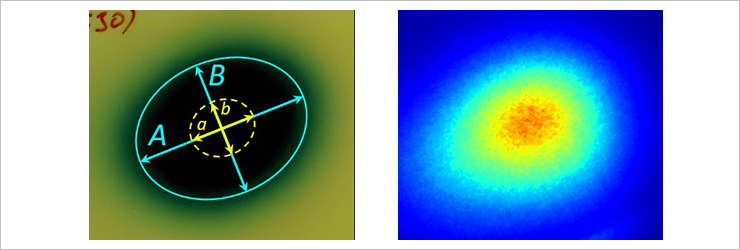 The track of the 124Xe54+ beam with an energy of 3.8 GeV/nucleon in a radiochromic film (on the left) and the beam profile at the OCTAVIUS 1500XDR Detector (on the right). Geometrical parameters of the irradiation area: A = 34.2 mm, B = 29.3 mm; the most uniform area: a = 12 mm, b = 9 mm
The track of the 124Xe54+ beam with an energy of 3.8 GeV/nucleon in a radiochromic film (on the left) and the beam profile at the OCTAVIUS 1500XDR Detector (on the right). Geometrical parameters of the irradiation area: A = 34.2 mm, B = 29.3 mm; the most uniform area: a = 12 mm, b = 9 mm
During the first days of work at the new stand, specialists performed a number of scientific and methodological tasks on beam diagnostics and dosimetry. Active work of a team of specialists of the MRNC named after A. F. Tsyba, which involved a complex of its own dosimetry equipment for accurate dosimetry in the field of ion therapy, made it possible to establish the main parameters of the beam and plan irradiation schemes for various samples.
Tasks of IBMP RAS in this run were related to the study of protective properties, radiation resistance, and radio modification of composite materials for the space industry, developed and produced at V. G. Shukhov Belgorod State Technological University (BSTU).
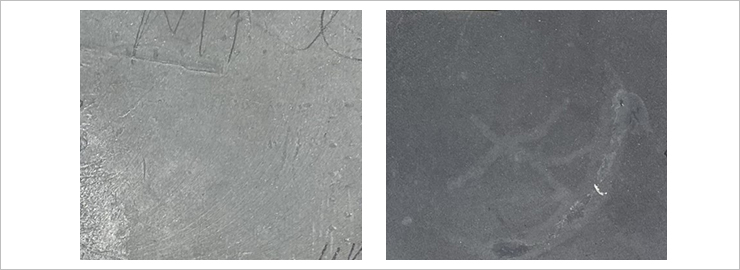 Composite No. 1 (on the left) and composite No. 2 (on the right)
Composite No. 1 (on the left) and composite No. 2 (on the right)
During the second experiment of IBMP RAS in the run at the NICA complex, specialists were working on the resource support for spacecraft crews related to the determination of the effect of heavy ions on seed germination and plant development features that are of practical interest from the point of cultivation in space flight.
Specialists of FRC CP RAS were solving problems of studying the structural modification and state of matter as a result of the action of accelerated ion beams on artificial sapphires (Al2O3).
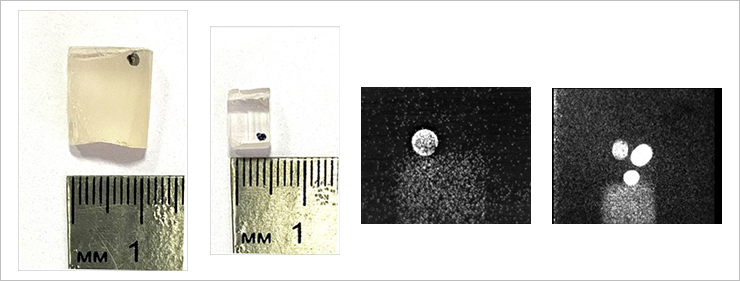 Samples of irradiated artificial sapphires (on the left). Examples of earlier results of FRC CP RAS (on the right): photos of millimeter-sized aluminum oxide melt bubbles formed during the sapphire surface irradiation in vacuum by a powerful laser pulse
Samples of irradiated artificial sapphires (on the left). Examples of earlier results of FRC CP RAS (on the right): photos of millimeter-sized aluminum oxide melt bubbles formed during the sapphire surface irradiation in vacuum by a powerful laser pulse
A significant part of the programme of FRC CP RAS in this run was devoted to the study of radiation damage of thin polymer films up to 100 µm thick, created on the basis of polytetrafluoroethylene (PTFE and thermoradiationally modified PTFE), polyethylene terephthalate, polyethylene, polyimide, and irradiated with beams of accelerated xenon ions with an energy of 3.8 GeV/nucleon.
Specialists of JIHT RAS were working on one of the important tasks of the run related to the irradiation of tapes made of high-temperature superconductors, high-temperature superconducting tapes of the 2nd generation produced by JSC “S-Innovations” (Moscow).
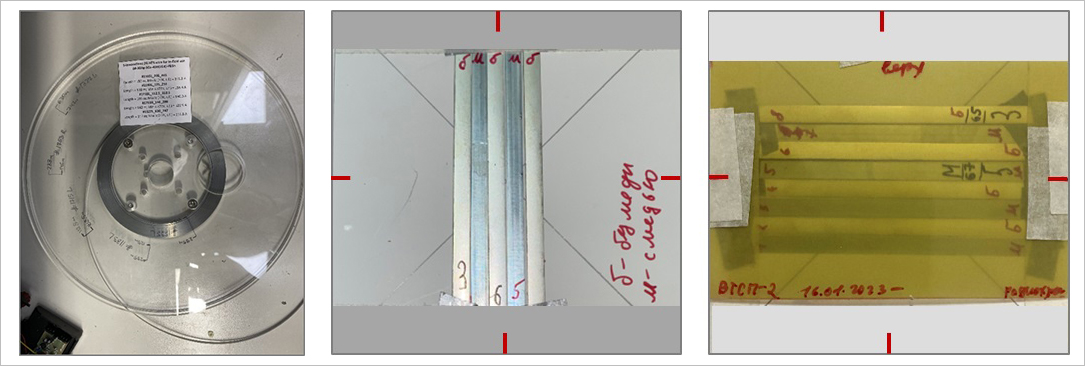
 High-temperature superconducting tape (on the left) and samples of tapes of different composition for irradiation (in the centre and on the right)
High-temperature superconducting tape (on the left) and samples of tapes of different composition for irradiation (in the centre and on the right)
The aim of the JINR – JIHT RAS joint research in this direction is to develop methods for increasing the critical current – the maximum current that a superconductor can withstand without loss of superconductivity by creating radiation defects (pinning centres). In the experiment, specialists were irradiating vertically and horizontally located high-temperature superconducting tapes with and without copper coating.
The experiment programme also covered research on irradiation of targets of various metals and measurement of induced activity spectra. In particular, researchers identified isotopes 7Be, 22Na, and 24Na in the spectra of aluminium targets irradiated with 124Xe54+ ions with an energy of 3.8 GeV/nucleon. Currently, specialists continue working on the analysis of all the obtained spectra and determination of yields of the detected nuclides.
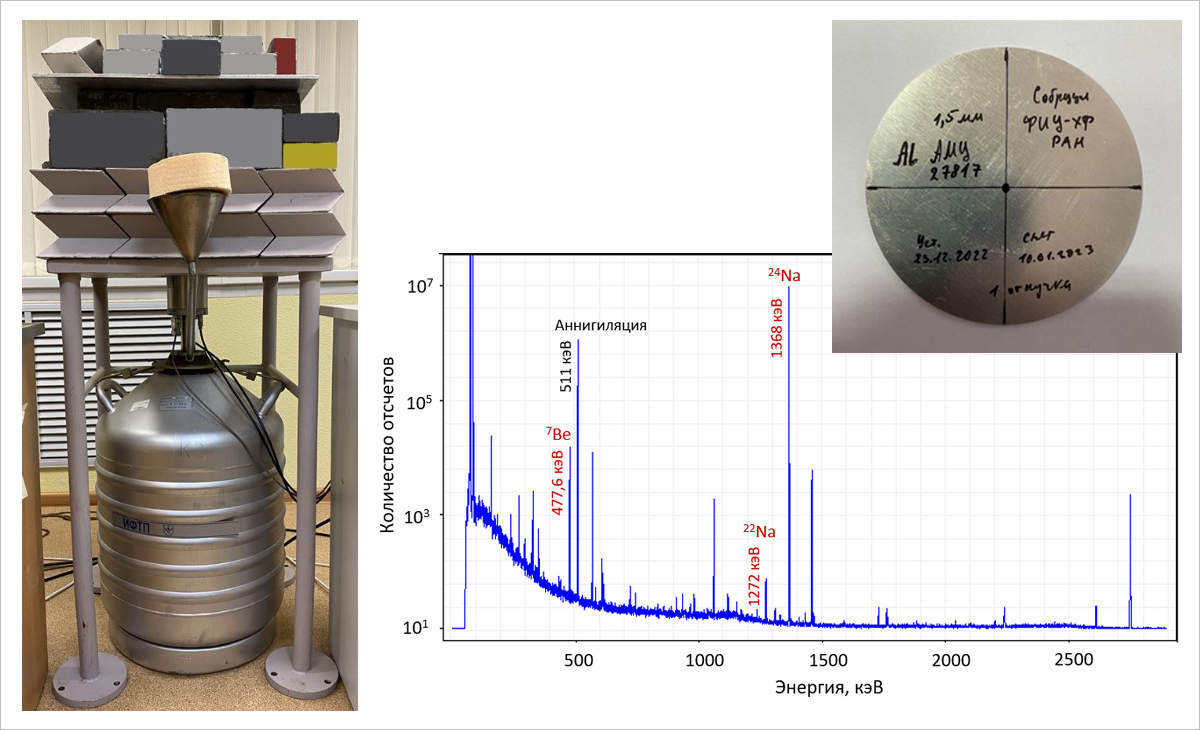 On the left: the SEG-1KP-IFTP gamma radiation spectrometer for measuring induced activity with the BDEG-OGK-3K detection unit and a protection unit for sample location. On the top right: aluminium target, 3 pcs x 1.5 x Ø70 mm. On the right below: energy spectrum of an aluminium target irradiated with 124Xe54+ ions with an energy of 3.8 GeV/nucleon. The energies of some maxima in the spectrum by which isotopes were identified are shown
On the left: the SEG-1KP-IFTP gamma radiation spectrometer for measuring induced activity with the BDEG-OGK-3K detection unit and a protection unit for sample location. On the top right: aluminium target, 3 pcs x 1.5 x Ø70 mm. On the right below: energy spectrum of an aluminium target irradiated with 124Xe54+ ions with an energy of 3.8 GeV/nucleon. The energies of some maxima in the spectrum by which isotopes were identified are shown
Concluding the results of the run, in which specialists mainly worked on tasks of studying the properties of materials under the influence of xenon ions with relatively high energies, Oleg Belov highlighted that most of the conducted research was pioneering, aimed at solving the fundamental problem of radiation materials science, i.e. establishing the relationship between the magnitude of the radiation effect and the characteristics of the used ionizing radiation. Determining the correlation between changes in the properties of materials and the parameters of radiation exposure is of fundamental importance for improving the reliability of the predicted radiation resistance of materials. Such materials are used in devices operating in fields of ionizing radiation, primarily in space, nuclear medicine, and nuclear engineering. It makes it possible to optimise the usage modes of rocket and space and nuclear technology, improve the weight and size characteristics of devices, and develop new methods of protecting materials from radiation.
Exposure to high-energy radiation can lead to fundamentally new channels for the dissipation of absorbed ionizing radiation energy at the physical, physical and chemical, and chemical stages of radiolysis. Therefore, as a result of the research carried out within the framework of the ARIADNA collaboration, specialists should expect the appearance of new radiation and chemical and/or nuclear and physical technologies, as well as solutions to urgent problems in the field of biomedical research, in the space industry, and related areas.
“The most of the data on the experiment has to be obtained yet. After the run, specialists continue analysing samples at specialised institutes, participants of the ARIADNA collaboration, using a wide range of analytical methods. In general, the current stage can be characterised as a successful start of work. At present, specialists have all opportunities for further development of research at the created stand at the BM@N experimental zone and the scientific programme for other directions in addition to what has been done in the field of radiation materials science. Based on the results of the work, I would like to highlight the efforts of the staff of the VBLHEP Department No. 5 and colleagues from other departments and laboratories who contributed to the implementation of this experiment,” Oleg Belov concluded.